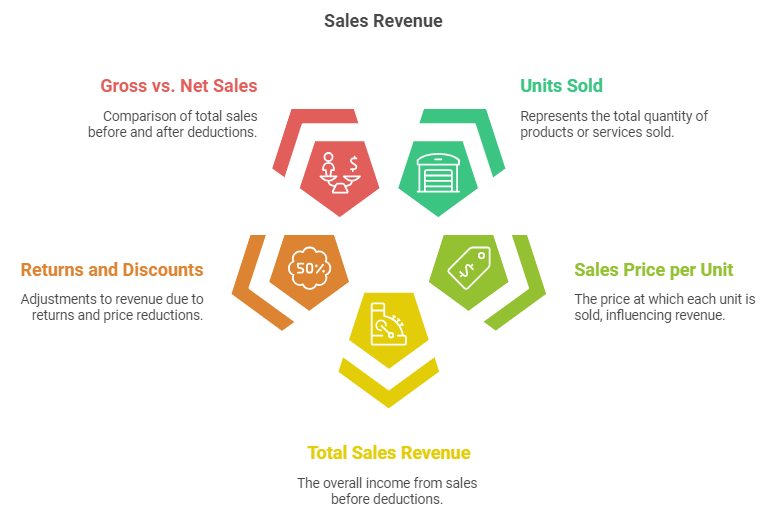Sales revenue is a fundamental business metric representing the income generated from selling goods or services. Therefore, accurately calculating sales revenue can be challenging yet crucial for many business owners to undertake as it directly impacts a business's financial analysis and strategic planning phases.
It is fair to say that without precise sales revenue figures, a business might struggle to set profit goals, adjust pricing strategies, or evaluate overall performance. Hence, in this blog, we will help you understand sales revenue, explore its components and calculation methods, and highlight its significance in financial reporting and decision-making.
From distinguished gross versus net sales issues to practical calculation examples, you'll gain comprehensive insights into managing sales revenue effectively. So, without much ado, let us explore how to accurately extract and compute sales revenue from an income statement, thereby helping businesses in the Philippines track their earnings efficiently.

Sales Revenue - What is it, And Why is it Important For Philippine Businesses

Sales revenue is a company's total income from selling goods or providing services over a specific period, typically before any expenses or costs are deducted. It represents the core operating income and is a crucial metric for assessing a company’s performance.
- It is calculated as Sales Revenue = Units Sold × Sales Price per Unit.
Essentially, sales revenue provides insights into demand, pricing strategies, and market reach, making it vital for financial planning and growth assessments.
For instance, if a business records PHP 100k in product sales, this amount appears as its gross sales revenue before any deductions, such as returns or discounts, are applied.
Also Read: Simple Steps to Prepare a Cash Flow Statement Model
Essential Components of Sales Revenue
Sales revenue is a business's total income from selling goods or services. It comprises several key components that provide insights into a company's financial performance.
Hence, thoroughly understanding these components will help businesses calculate their sales revenue accurately and, ultimately, track their business success.
Here are the essential components of sales revenue in the Philippines -

1. Units Sold
This refers to the total number of products or services sold within a specific period. It forms the base for calculating sales revenue.
- Formula: Units Sold = Total Quantity of Goods Sold
Example: If a business sells 500 units of a product, the units sold are 500.
2. Sales Price per Unit
This is the price at which each unit is sold. It can vary based on discounts, promotions, or product types.
- Formula: Sales Price per Unit = Revenue ÷ Units Sold
Example: If a business sells 500 units at PHP 100 per unit, the sales price per unit is PHP 100.
3. Total Sales Revenue
Total sales revenue is the product of the units sold and the price per unit. This is the primary figure businesses report on their income statement.
- Formula: Total Sales Revenue = Units Sold × Sales Price per Unit
Example: If 500 units are sold at PHP 100 each, the total sales revenue would be 500 × PHP 100 = PHP 50k.
4. Returns and Discounts
Returns and discounts reduce the total sales revenue. Companies must account for returned goods and price reductions when calculating net sales revenue.
- Formula: Net Sales Revenue = Total Sales Revenue - Returns and Discounts
Example: If PHP 2k in returns and discounts are included, the net sales revenue from PHP 50k in total revenue would be PHP 50k - PHP 2k = PHP 48k.
5. Gross Sales vs. Net Sales
Gross sales refer to the total revenue from sales before any deductions like returns or allowances, while net sales account for those adjustments, giving a clearer view of actual earnings.
- Formula: Net Sales = Gross Sales - Returns - Discounts
Example: If gross sales are PHP 50k and the business has PHP 2k in returns and PHP 1k in discounts, the net sales would be PHP 50k - PHP 2k - PHP 1k = PHP 47k.
Are you having difficulty identifying your business ‘Net Sales,’ especially on the Yahoo finance tool? If yes, check out this Reddit thread for more information. Multiple Reddit users shared their confusion regarding identifying 'net sales' on the income statement, suspecting it might be 'Total Revenue.'
Also Read: Types of Business Loans: Comparing Different Financing Options
How to Calculate Sales Revenue Using an Income Statement in The Philippines
Calculating sales revenue from an income statement is essential for understanding a business’s performance. The sales revenue section mainly reflects the total income generated from the sale of goods or services.
Here’s a step-by-step guide to calculating sales revenue using an income statement:
1. Locate the ‘Revenue’ or ‘Sales’ Section
On the income statement, look for the section labeled ‘Sales Revenue,’’ Net Sales,’ or simply ‘Revenue.’ This figure represents the total income generated from selling goods or services within the period.
Example: If a retail business has PHP 1 million listed under ‘Net Sales,’ this is the total sales revenue.
2. Add Additional Revenue Sources (If Applicable)
These are often listed separately if the business has multiple income streams, such as service fees or commissions. To calculate total sales revenue, add all operating income related to the sale of goods or services.
Example:
- Net Sales: PHP 1 million
- Commissions: PHP 200k
- Total Sales Revenue = PHP 1 million + PHP 200k = PHP 1.2 million
3. Account for Returns and Allowances
Returns, discounts, and allowances reduce sales revenue. These figures are subtracted from the gross sales to give net sales revenue.
Example:
- Gross Sales: PHP 1.2 million
- Returns: PHP 50k
- Discounts: PHP 30k
- Net Sales Revenue = PHP 1.2 million - PHP 50k - PHP 30k = PHP 1.12 million
4. Confirm Using the Income Statement Total
The final figure listed as "Sales Revenue" or "Net Sales" should reflect the business's total revenue after all returns and discounts have been accounted for.
Check out this video to learn how to first make a basic income statement from which you can calculate your business’s sales revenue.
Also Read: Small Business Equipment Financing Options
Calculating Sales Revenue For Product-based And Service-based Businesses in The Philippines
When it comes to calculating sales revenue, the method you use depends on whether you're running a product-based or a service-based business. Though the processes share some similarities, there are distinct differences worth noting.
Here’s a glimpse into the differences between calculating sales revenue for product-based businesses and service-based businesses in the Philippines -
Product-based Businesses
In product-based businesses, sales revenue is all about the numbers and prices. Start by determining how many units you've sold during a specific period. This might involve counting inventory or using sales reports. Then, identify the price at which each unit was sold.
Finally, multiply these two figures by the number of units sold and the unit price. This simple multiplication gives you the total sales revenue.
For example, if a candle shop sold 500 candles at PHP 10 each, their sales revenue would be 500 times PHP 10, equating to PHP 5k.
Service-based Businesses
In contrast, service-based businesses take a slightly different approach. Here, the number of customers served replaces the number of units sold. Begin by counting the total number of customers you've provided services to during the designated timeframe.
Then, figure out the average price of the services rendered per customer. Again, a simple multiplication of these figures will yield the sales revenue.
For instance, a yoga studio that had 300 clients monthly and charged an average of PHP 20 per session would calculate its sales revenue by multiplying 300 by PHP 20, totaling PHP 6k.
While the initial calculations provide a snapshot of gross sales revenue, it's essential to consider any subtractions for discounts, allowances, or returns to get a precise picture of net revenue.
Also Read: Understanding Working Capital: How to Calculate and its Importance
Accelerate your Philippine SMEs' growth exponentially! Apply today for N90’s fast financing solutions and get potential loan approvals within 24 hours! Unleash your business’s full potential today! Get in touch with us to learn more.
Importance of Accurate Sales Revenue Calculation For Philippine Businesses

Accurate sales revenue calculation is essential for businesses in the Philippines, as it helps them make informed financial decisions, assess growth, and ensure compliance with financial regulations.
Here’s why accurate sales revenue calculation is essential for businesses in the Philippines -
1. Financial Health Assessment
Correctly calculating sales revenue helps businesses track their performance, identify growth trends, and adjust for future planning. It also provides a clear picture of profitability and overall financial health.
2. Strategic Decision-Making
With accurate data, businesses can make better decisions about product pricing, inventory management, and market strategies. Understanding revenue trends helps identify opportunities for expansion or cost-cutting.
3. Compliance with Tax Regulations
In the Philippines, businesses must report revenue accurately for tax purposes. Incorrect revenue figures can lead to penalties or issues with the Bureau of Internal Revenue (BIR), making accurate calculations crucial for compliance.
4. Investor Confidence
Investors and lenders rely on accurate sales revenue figures to evaluate the potential for returns. Transparency in revenue reporting boosts confidence in the business, improving access to funding and investment.
5. Budgeting and Forecasting
Accurate revenue figures are essential for creating realistic budgets and financial forecasts. This helps businesses allocate resources efficiently, plan for future growth, and avoid cash flow problems.
Also Read: How Does A Bridge Loan Work For a Small Business?
Role of Sales Revenue in Financial Forecasting For Businesses in Philippines
In the world of business, numbers are the language of planning; hence, companies must be able to predict their financial future to craft a successful strategy. This is where sales revenue becomes invaluable.
Sales revenue is crucial in financial forecasting, providing businesses with the data needed to predict future performance. Accurate sales forecasting is essential for making strategic decisions and ensuring sustainable growth for Philippine companies.
Here’s how sales revenue influences financial forecasting for businesses of all sectors in the Philippines -
1. Foundation for Revenue Projections
Historical sales revenue data serves as the basis for projecting future earnings. Businesses can estimate future revenues by analyzing past sales trends, helping them effectively plan budgets, marketing strategies, and resource allocation.
2. Cash Flow Forecasting
Sales revenue helps predict cash inflows, which are crucial for maintaining positive cash flow. Accurate forecasts allow businesses to plan for expenses like salaries, operational costs, and investments, ensuring smooth financial management.
3. Profitability Analysis
Projected sales revenue enables businesses to estimate profits by comparing expected revenue against forecasted expenses. This helps business owners in the Philippines assess whether their operations are sustainable or need adjustments.
4. Inventory and Supply Chain Planning
With reliable sales revenue forecasts, businesses can better manage inventory levels and ensure supply chain efficiency. They avoid overstocking or understocking products by predicting demand based on revenue forecasts.
5. Investor and Lender Confidence
Financial forecasts backed by solid sales revenue projections enhance investor and lender confidence. They clearly understand the business's potential to generate returns, improving access to funding or investment opportunities.
6. Resource Allocation and Growth Planning
Accurate sales forecasts help businesses allocate resources efficiently, whether for expanding operations, hiring new staff, or launching new products. Revenue projections are essential for setting long-term goals and strategies.
Also Read: Small Business Startup Funding for Women
Sales Revenue Practical Calculation Examples in The Philippines
Understanding sales revenue provides foundational insight into a business's financial operations. Let's examine some practical examples to see how sales revenue is calculated in both product-based and service-based businesses, offering clarity through real-world scenarios -
Example Calculations for Product-Based Businesses
In product-based businesses, sales revenue involves straightforward quantifiable data – the number of units sold and the price per unit. Consider 'Anavrin Baked Goods,' a bakery that's having a bustling day.
They sold 500 cakes at PHP 20 each and 300 loaves of bread at PHP 5 each. To calculate the total gross sales revenue, the formula is relatively straightforward -
- Sales Revenue from Cakes = 500 x PHP 20 = PHP 10k
- Sales Revenue from Bread = 300 x PHP 5 = PHP 1.5k
- Total Gross Sales Revenue = PHP 10k + PHP 1.5k = PHP 11.5k
If there are returns or discounts during a sales period, these would be subtracted from the gross sales revenue to calculate the net sales revenue.
For instance, with PHP 1k in returns and PHP 500 in discounts, Anavrin Baked Goods would record a net sales revenue of PHP 10k.
Example Calculations for Service-Based Businesses
In service-based businesses, sales revenue calculations may involve variable pricing or service delivery timelines.
Consider a lawn care company offering two types of services: basic lawn service and an all-inclusive package. Here’s how they calculate their sales revenue -
- Sales Revenue from Basic Lawn Services = 15 x PHP 50 = PHP 750
- Sales Revenue from All-Inclusive Lawn Services = 10 x PHP 100 = PHP 1k
- Total Sales Revenue = PHP 750 + PHP 1k = PHP 1.75k
These calculations highlight the importance of accurately recognizing revenue based on service completion or delivery. Ensuring that revenue aligns accurately with the rendered services is essential to providing an accurate picture of business performance in financial statements.
Additionally, consider companies offering diverse product lines like electronics, clothing, and home goods. Revenue calculations for each product line should be conducted separately:
Electronics:
- Sales Revenue from TVs = 100 x PHP 800 = PHP 80k
- Sales Revenue from Laptops = 50 x PHP 1.2k = PHP 60k
Clothing:
- Sales Revenue from Shirts = 200 x PHP 20 = PHP 4k
- Sales Revenue from Pants = 150 x PHP 30 = PHP 4.5k
Home Goods:
- Sales Revenue from Kitchen Utensils = 300 x PHP 10 = PHP 3k
- Sales Revenue from Bed Sheets = 200 x PHP 25 = PHP 5k
- Total Sales Revenue = PHP 80k + PHP 60k + PHP 4k + PHP 4.5k + PHP 3k + PHP 5k = PHP 156.5k
These examples show how various businesses calculate their sales revenue, which forms the backbone of financial analyses and strategic business decisions.
Also Read: Startup Business Loans: How to Get Them for Your Business Needs
Core Difference Between Total Revenue And Sales Revenue
Understanding the nuances between sales revenue and total revenue is essential for a clear picture of a company's financial health. While sales revenue serves as a critical indicator of operational efficiency, total revenue encompasses a broader array of income sources that can offer additional insights.
Total revenue refers to a business's overall income from all activities, including operating and non-operating income sources. It encompasses income from sales, investments, interest, royalties, or any other form of financial gain within a specific period.
For example, if a business earns from selling products and also receives dividends or rental income, all these are combined to form total revenue. Total revenue provides a broad view of the company's income across all streams.
Sales revenue, on the other hand, specifically refers to income generated from the core business activities, such as selling goods or providing services. It focuses solely on the revenue earned from customer transactions directly tied to the company's primary business operations.
For example, for a retail store, sales revenue is the money earned from selling products, excluding any additional sources like investment returns or interest income. Sales revenue is a subset of total revenue and is crucial for assessing the business’s operational success.
In summary, while total revenue includes all forms of income, sales revenue is limited to the earnings from the company’s primary business activities.
Conclusion
After exploring all of its essential components and precise calculation methods through this comprehensive article, it is pretty evident that accurate sales revenue figures are indispensable and fundamental elements for gauging a Philippine business’s performance and ensuring its stable financial health.
Essentially, accurate sales revenue calculations allow businesses to make the right financial decisions to match their needs, strategize effectively, and help allocate their resources judiciously.
Hence, precise sales revenue calculation isn't just a practice in financial management; it's the compass that guides companies toward sustainable growth and sound financial planning.
Moreover, by focusing on this vital metric, Philippine companies can better evaluate their core activities and distinguish sales revenue from total revenue, thereby gaining a clearer picture of their operational success and areas for improvement.
Frequently Asked Questions (FAQs)
1. How do you find sales revenue on an income statement?
To find sales revenue on an income statement, look for the section labeled "Revenue," "Sales," or "Net Sales" at the top of the statement.
Sales revenue represents the total income from selling goods or services before any deductions for expenses. It is typically the first figure reported, giving a snapshot of the business's primary earnings.
2. How is the sales figure calculated on an income statement in the Philippines?
The sales figure on an income statement in the Philippines is calculated by multiplying the units sold by the price per unit. Additionally, deductions like returns, discounts, and allowances are subtracted from the gross sales to determine net sales revenue.
Essentially, this figure represents the total revenue generated from the sale of goods or services during a given period.
3. Are sales and revenue the same on an income statement?
Yes, sales and revenue are often the same on an income statement, particularly when referring to income from core business activities. Sales revenue specifically reflects earnings from the sale of goods or services.
However, total revenue may include additional income sources like interest or dividends, making "sales" a subset of "revenue" in broader financial contexts.
4. How do you calculate sales revenue on a pro forma income statement in the Philippines?
To calculate sales revenue on a pro forma income statement in the Philippines, multiply the expected units sold by the projected price per unit. For example:
Sales Revenue = Expected Units Sold × Projected Price Per Unit.
Ensure you account for any expected returns or discounts to get net sales revenue. This provides a forecast of the business's primary income from sales over a future period.













